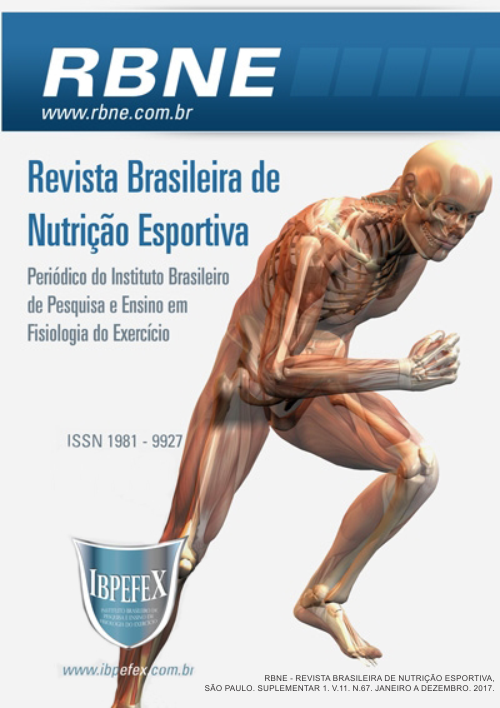Influence of the use of lepidium meyenii walp and tribulus terrestris in bodybuildings
Abstract
The use of herbal supplements can be advantageous, because it is efficient in promoting beneficial effects to the organism and high rates of therapeutic effects and low incidence of side effects; Some of these are: Lepidium Meyenii Walp and Tribulus terrestris. The present study aims to evaluate the effects of the consumption of the substances Lepidium Meyenii Walp (Maca Peruana) associated with Tribulus terrestris (Tribulus terrestre) in bodybuilders. A field study was carried out with 16 students who were practicing bodybuilding through a randomized controlled study, being selected adult male students aged between 18 and 40 years, who trained at least three times a week. The results were evaluated by means of a questionnaire and physical evaluation. After 30 days of initiating substance administration, the results were analyzed and there were no significant changes in the physical parameters of the study participants. Some variables may have influenced the results of the present study. Among them, we can mention: the size of the sample; The selected indicators and factors exogenous to the experiment, for example, the participants' diet, which was not totally controlled. Regarding the questionnaire, 83.3% of the participants in Group C (control) stated that they had improved libido and physical performance and in Group TM (Tribulus+Maca) 100% of the participants stated that they had improved physical performance and 37.5% improved libido. The study showed that the use of Tribulus Terrestris and Lepidium meyenii Walp (Maca Peruana) did not influence the body composition of bodybuilders, but improved physical performance and libido.
References
-Batistuzzo, J.A.O.; Itaya, M.; Eto, Y. Formulário Médico Farmacêutico. São Paulo. Ed. Pharmabooks. 2011. 4ªedição. p. 213-219.
-Brandão, F. R.; Júnior, G. A. O uso de substâncias nocivas associadas ao comportamento de risco do praticante de atividade física. Revista Psicologia e Saúde em Debate. Vol. 1. Num. 1. 2015.
-Carrano, T. L. As consequências da fitoterapia no Tratamento da obesidade: uma revisão de literatura. TCC. Faculdade de Ciências Aplicadas da Universidade Estadual de Campinas. Limeira. 2015.
-Celloni, I. S. Caracterização centesimal e espectral da Maca Peruana (Lepidium meyenii Walp). TCC de graduação. Universidade Tecnológica Federal do Paraná. Campo Mourão. 2014.
-Conde, B. E.; Macedo, A. L.; Fonseca, A. S.; Siqueira, A. M.; Souza, G. H. L.; Martins, A. E.; Rogério, I. T. S. Estudo crítico sobre utilização de fitoterápicos por praticantes de exercício físico em academias de musculação. Revista Biológicas & Saúde. Vol. 5. Num.16. 2015.
-Cortez, A. C. L.; Vieira, F. H. M.; Barros, L. L.; Martins, M. D. C. C. O uso de suplementos alimentares, em praticantes de musculação: uma revisão de literatura. Saúde em Foco. Vol. 2. Num. 1. 2015. p. 1-11.
-Cunha, I. F. Avaliação do efeito neuroprotetor do extrato pentanólico do Lepidium meyenii(maca)em modelo animal experimental de acidente vascular cerebral isquêmico focal. Dissertação de Mestrado. Curso de Pós-Graduação. Faculdade de Ciências Médicas da Santa Casa de São Paulo. São Paulo. 2015.
-Gauthaman, K. P. G.; Adaikan, R. N. V. Prasad. "Aphrodisiac properties of Tribulus Terrestris extract (Protodioscin) in normal and castrated rats."Life Sciences. Vol. 71. Num. 12. 2002. p. 1385-1396.
-Gonzales, G. F.; Rubio, J.; Chung, A.; Gasco, M.; Villegas, L. Effect of alcoholic extract of Lepidium meyenii (Maca) on testicular function in male rats.Asian journal of andrology. Vol. 5. Num. 4. 2003. p. 349-349.
-Hussain, A.A.; Mohammed, A.A.; Ibrahim, H.H.; Abbas, A.H.; Study the Biological Activities of TribulusTerrestris Extracts. World Academy of Science, Engineering and Technology. International Journal of Chemical, Molecular, Nuclear, Materials and Metallurgical Engineering. Vol. 3. Num. 9. 2009.
-Jackson, A.S.; Pollock M.L. Ward A. Generalized equations for predicting body density of men. Br J Nutr. Vol. 40. 1978. p. 497-504.
-Junior, H. P. L.; Lemos, A. L. A.; Lemos, L. M. D. Tribulus terrestris. Centro Cochrane do Brasil. Diagnóstico Tratamento. Vol. 16. Num. 4. 2011.
-Neychev, V. K.; Mitev, V. I. The aphrodisiac herb Tribulus terrestris does not influence the androgen production in young men. Journal of ethnopharmacology. Vol. 101. Num. 1. 2005. p. 319-323.
-Pokrywka, A.; Obmiński, Z.; Malczewska-Lenczowska, J.; Fijatek, Z.; Turek-Lepa, E.; Grucza, R. Insights into supplements with Tribulus terrestris used by athletes.Journal of human kinetics. Vol. 41. Num.1. 2014. p. 99-105.
-Rogerson, S.; Riches, C. J.; Jennings, C.; Weatherby, R. P.; Meir, R. A.; Marshall-Gradisnik, S. M. The effect of five weeks of Tribulus terrestris supplementation on muscle strength and body composition during preseason training in elite rugby league players. The Journal of Strength & Conditioning Research, Vol. 21. Num. 2. 2007. p. 348-353.
-Sanabria, G. G. R.; Pires, T. C. R.; Filho, F. F. Preliminary approach to detect amylolytic and pectinolytic activities from maca (Lepidium meyenii Walp.) Revista Brasileira de Ciências Farmacêuticas. Vol. 42. Num.1. 2006.
-Tantawy, W. H. E.; Temraz, A.; Gindi, O. D. Free Serum Testosterone Level in Male Rats Treated with Tribulus Alatus Extracts. Investigative Urology Tribulus Alatus Extracts and Testosterone Level International Braz J Urol. Vol. 33. Num. 4. 2007. p. 554-559.
-WHO, World Health Organ. Tech Rep Ser. Diet, nutrition and the prevention of chronic diseases. p. 1-149. 2003.
Authors who publish in this journal agree to the following terms:
- Authors retain the copyright and grant the journal the right of first publication, with work simultaneously licensed under the Creative Commons Attribution License BY-NC which allows the sharing of the work with acknowledgment of the authorship of the work and initial publication in this journal.
- Authors are authorized to enter into additional contracts separately for non-exclusive distribution of the version of the work published in this journal (eg, publishing in institutional repository or book chapter), with acknowledgment of authorship and initial publication in this journal.
- Authors are allowed and encouraged to post and distribute their work online (eg, in institutional repositories or on their personal page) at any point before or during the editorial process, as this can bring about productive change as well as increase impact and impact. citation of published work (See The Effect of Free Access).






